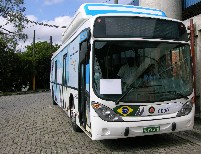« Ecological Cities as Economic Cities | Home | A Loan to Improve Colombia’s Water and Sanitation Services »
Latin America’s First Hydrogen Bus
By Keith R | July 1, 2009
Topics: Air Quality, Motor Vehicles, Sustainable Transport | No Comments »
 Brazil is known for many “green” experiments and firsts in transportation. Think of Curitiba’s groundbreaking work on bus rapid transit, Brazil’s pioneering work on sugarcane ethanol and use of flex-fuel vehicles, the country’s aggressive biodiesel program, Vale’s trains run on biodiesel, Itaipu’s development of electric cars that can be charged from biodigestors, and the use of recycled cooking oil as fuel for public buses in cities such as Rio de Janeiro.
Brazil is known for many “green” experiments and firsts in transportation. Think of Curitiba’s groundbreaking work on bus rapid transit, Brazil’s pioneering work on sugarcane ethanol and use of flex-fuel vehicles, the country’s aggressive biodiesel program, Vale’s trains run on biodiesel, Itaipu’s development of electric cars that can be charged from biodigestors, and the use of recycled cooking oil as fuel for public buses in cities such as Rio de Janeiro.
Add this one to the list: Latin America’s first hydrogen-powered buses (for that matter, the first in the Southern Hemisphere).
Testing of the hydrogen-powered bus began this week in São Bernardo do Campo, a suburb of São Paulo; it should start taking passengers in August. It travels down the São Mateus-Jabaquara corridor and will have the same fare as a common bus.
The bus does not emit any kind of pollution: in place of CO2 and other pollutants from ordinary vehicles, it produces water.
For the passengers, it will be difficult to tell it apart from other buses — it will have the same amenities. However, the bus’ operation is so quiet that its driver, Andréia Fazolin, says that it’s sometimes it is difficult to tell when the bus is switched on. Another difference for the drivers will the onboard computer, with a read-out screen next to the steering wheel, so the driver can monitor the use of two hydrogen fuel cells and the car battery.
Brazil and China are the only two developing countries to take up the offer of the Global Environment Facility (GEF) to finance the introduction of such vehicles — from paper to operation –in five developing countries. The other three — Egypt, India and Mexico — did not take the project forward. Germany, Japan, the Netherlands and the US are working on a similar bus.
The Chinese and Brazilian projects have a key difference, however: the Chinese imported from Europe the hydrogen bus project ready-to-go, whereas Brazil developed its vehicle in-country, bringing together national and international technology. Although it had to import key components, such as the cell where the chemical reaction occurs that provides the energy for the bus, the chassis and other parts were developed in Brazil and the bus is assembled there. This makes Brazil to only developing nation to have its own model of hydrogen bus.
Furthermore, says Agenor Boff, director of Tuttitransporti, one of the companies responsible for building the bus, the Brazilian vehicle is the cheapest in the world. Even so, it is still expensive to construct. Tuttitransporti, GEF and the State of São Paulo hope that, after testing of the first one and more are built, costs will be driven down. [Temas Observation: if you travel much in Latin America and the Caribbean and use public buses or inter-city bus transport, you may have noticed that many of the buses used are built in Brazil — more specifically São Paulo. So if SP can work out the economics of constructing this bus, it may become a chief supplier of hydrogen buses to the developing world.]
The new project is the result of a five-year project supported by the UN Development Programme (UNDP), the Environment Ministry (MMA), the Metropolitan Enterprise for Urban Transport (Empresa Metropolitana de Transportes Urbanos – EMTU) and the GEF.
Tags: Brasil, Brazil, bus, China, CO2, Egypt, EMTU, GEF, Germany, hidrogênio, hydrogen, India, Japan, Mexico, MMA, Netherlands, ônibus, PNUD, São Bernardo do Campo, São Paulo, transporte coletivo, Tuttitransporti, UNDP, USA


